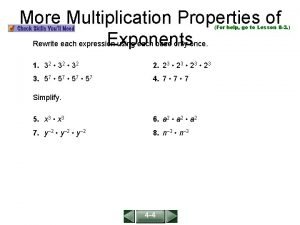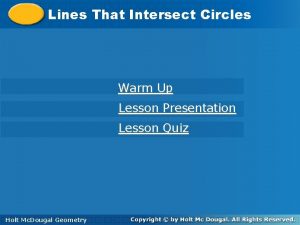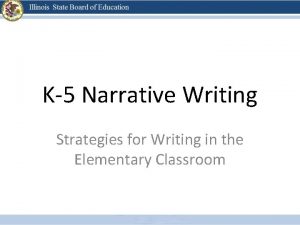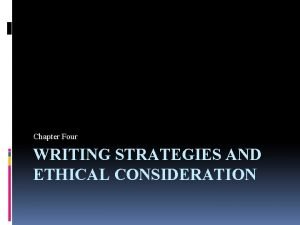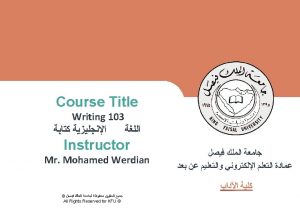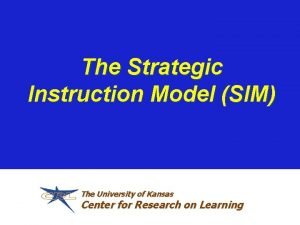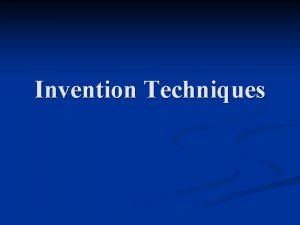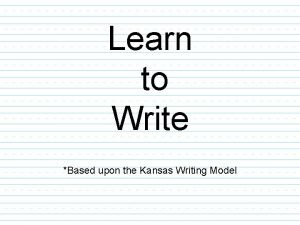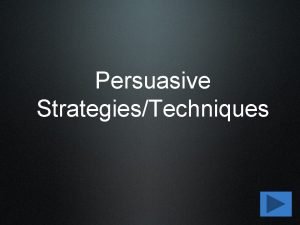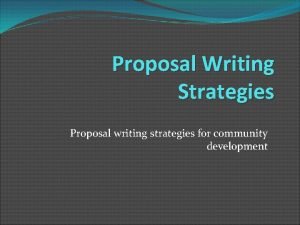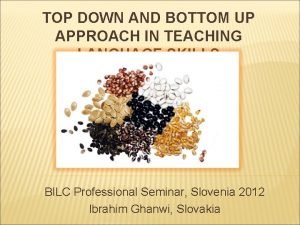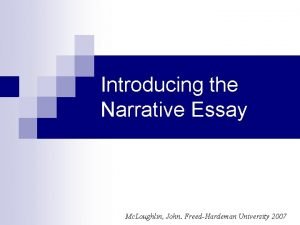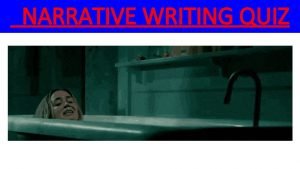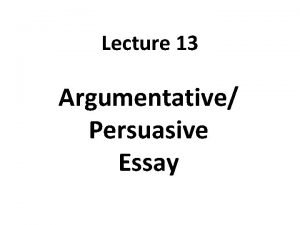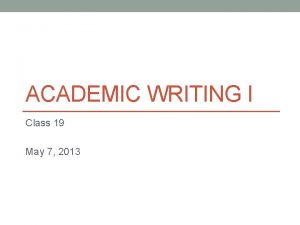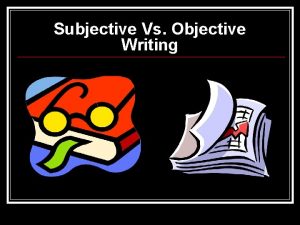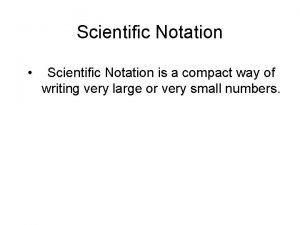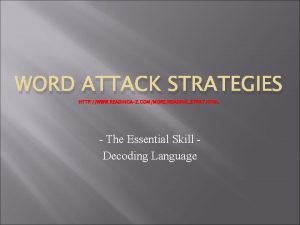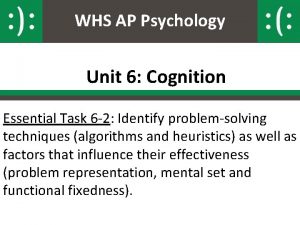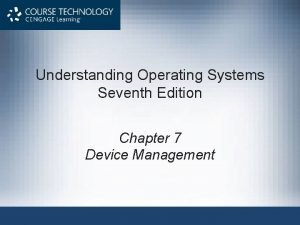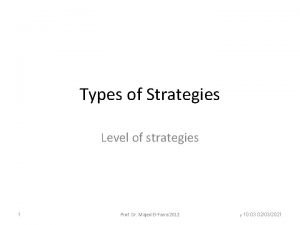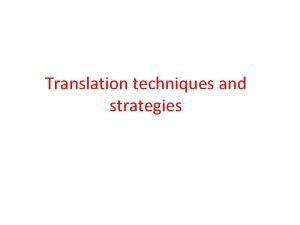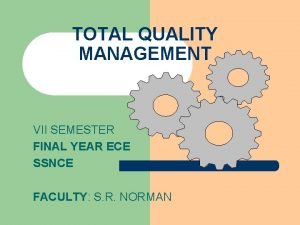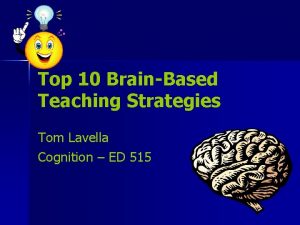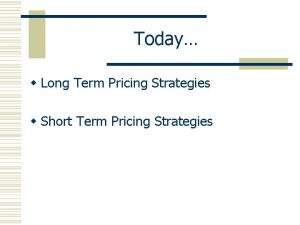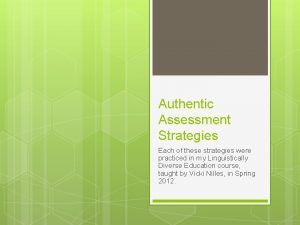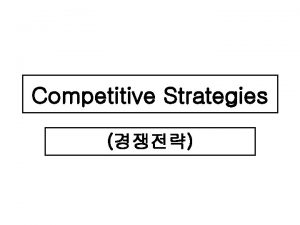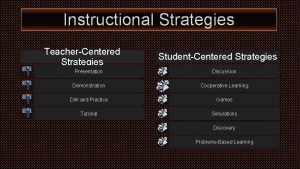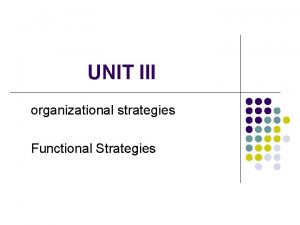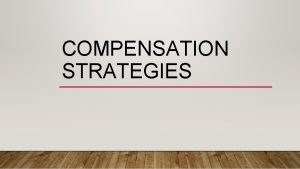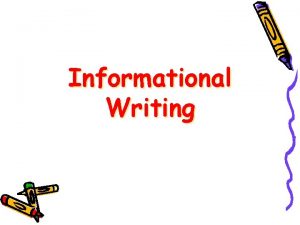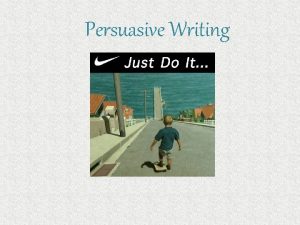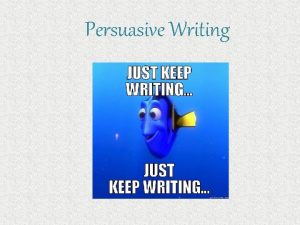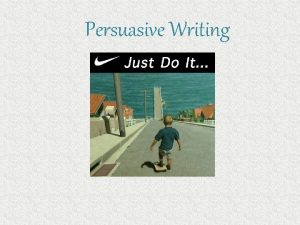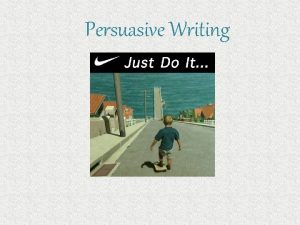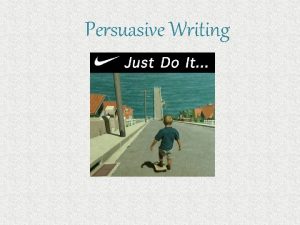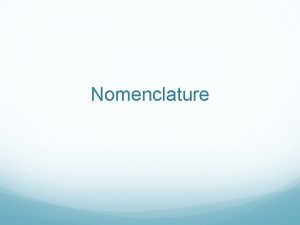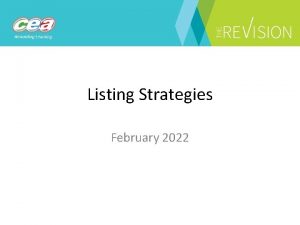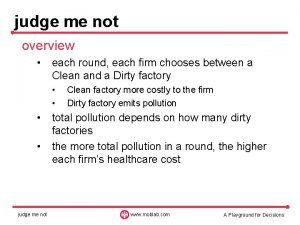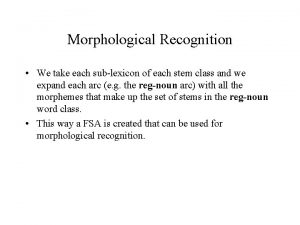AP Writing Strategies How To Approach Each Writing















































- Slides: 47

AP Writing Strategies How To Approach Each Writing Task

● ● ● Every Essay Every Time ● ● Use the standard format with an introduction, body, and conclusion, but do not force a formulaic and overly predictable five-paragraph essay. Include a thesis in the introduction Clearly divide ideas into separate paragraphs; clearly indent the paragraphs. Stay on topic; avoid irrelevant comments or ideas. Use sophisticated diction and sentences with syntactic variety. Be organized and logical in your presentation. Be sure to address all of the tasks the essay question requires.

The AP 9 -Point Scale

High Score High-scoring essays thoroughly address all the tasks of the essay prompt in well-organized responses. The writing demonstrates stylistic sophistication and control over the elements of effective writing, although it is not necessarily faultless. Overall, high-scoring essays present thoroughly developed, intelligent ideas; sound and logical organization; strong evidence; and articulate diction. ● 8 -9 ● Rhetorical analysis essays demonstrate significant understanding of the passage, its intent, and the rhetorical strategies the author employs. Argument essays demonstrate the ability to construct a compelling argument, observing the author’s underlying assumptions, (addressing multiple authors in the synthesis essay) and discussing many sides of the issues with appropriate evidence.

Medium-High Score 7 -6 Medium-scoring essays complete the tasks of the essay topic well—they show some insight but usually with less precision and clarity than high-scoring essays. There may be lapses in correct diction or sophisticated language, but the essay is generally well written. ● Rhetorical analysis essays demonstrate sufficient examination of the author’s point and the rhetorical strategies he uses to enhance the central idea. ● Argument essays demonstrate the ability to construct an adequate argument, understand the author’s point, and discuss its implications with suitable evidence. The synthesis argument will address at least three of the sources.

Medium 5 Essays that earn a medium score complete the essay task, but with no special insights; the analysis lacks depth and merely states the obvious. Frequently, the ideas are predictable and the paragraph development weak. Although the writing conveys the writer’s ideas, they are presented simplistically and often contain lapses in diction or syntax. ● Rhetorical analysis essays demonstrate uneven or insufficient understanding of how rhetorical strategies create an author’s point. Often, the writer merely lists what he or she observes in the passage instead of analyzing effect. ● Argument essays demonstrate the ability to present an argument, but they frequently provide limited and inadequate discussion, explanation, or evidence for the writer’s ideas. The writer may not address enough of the sources in the synthesis essay. Oversimplification of the issue(s) minimizes the essay’s effectiveness.

Medium-Low Essays 4 -3 These essays are weaker than the 5 score because the writer overlooks or perhaps misreads important ideas in the passage. The student may summarize the passage’s ideas instead of analyzing them. Although the writer’s ideas are generally understandable, the control of language is often immature. ● Rhetorical analysis essays demonstrate little discussion of rhetorical strategies or incorrect identification and/or analysis of those strategies. ● Argument essays demonstrate little ability to construct an argument. They may not clearly identify the author’s point, may not present multiple authors’ points of view in the synthesis essay, and may offer little evidence for the student’s position.

Low Essays 2 -1 These essays demonstrate minimal understanding of the topic or the passage. Perhaps unfinished, these essays offer no analysis of the passage and little or no evidence for the student’s ideas. Incorrect assertions may be made about the passage. Stylistically, these essays may show consistent grammatical problems, and sentence structure is usually simple and unimaginative. ● Rhetorical analysis essays demonstrate little ability to identify or analyze rhetorical strategies. Sometimes these essays misread the prompt and replace it with easier tasks, such as paraphrasing the passage or listing some strategies the author uses. ● Argument essays demonstrate little ability to understand the author’s point (or multiple authors in the synthesis essay) and then construct an argument that analyzes it. Minimal or nonexistent evidence hurts the essay’s effectiveness. Some students may substitute an easier task by presenting tangential or irrelevant ideas, evidence, or explanation. .

ite 25 the E Min ss ute ay s ad fre roo d. P an utes fine 5 Min Re Wr Pacing Planning 10 Minutes

Planning Spend about 10 minutes reading the topic and the passage carefully and planning your essay. This organizational time is crucial to producing a high-scoring essay. In the first 10 minutes, you need to follow these steps. Do it efficiently, and you’ll know what you want to write and the order in which you’ll present your ideas. 1. 2. 3. 4. Read the topic’s question carefully so that you know exactly what you’re being asked to do. Read the passage carefully, noting what ideas, evidence, and rhetorical devices are relevant to the specific essay prompt. Conceive your thesis statement, which will go in your introductory paragraph. Organize your body paragraphs, deciding what evidence from the passage you’ll include (using multiple passages in the synthesis essay) or what appropriate examples you’ll use from your knowledge of the world. Know what relevant remarks you’ll make about the evidence. Understand your body paragraph divisions—when you’ll begin a new paragraph and what idea unifies each paragraph. The importance of this planning phase cannot be overemphasized. When your essay has been planned well, your writing flows faster, your essay stays on topic and is well organized, and the paragraphs are well developed. You must practice this essential planning step several times before you take the actual AP exam.

Rhetorical Analysis Essay

Rhetorical Analysis: Read the Essay The Rhetorical Analysis is fundamentally a test of your ability to critically read complex text. Before you can even think about what you want to write, you have to understand the text. Read and Annotate: SOAPS Identify Rhetorical Devices, Strategies, and Style Analyze The How and Why of Devices, Strategies, and Style

Rhetorical Analysis: Read the Essay: Step One The Rhetorical Situation: Speaker, Audience, Topic Use SOAPS for this

Rhetorical Analysis: Read the Essay: Rhetorical Strategies ● Appeals (ethos, logos, pathos) ● Style (diction, syntax, details, imagery, tone, etc. ) Fill in the Explicit Side of the Chart Explicit Implicit

Rhetorical Analysis: Read the Essay: Analyze Rhetoric ● Why did the author choose these strategies for the particular audience, occasion, and/or purpose? ○ ○ This is the analysis part! Without this, you are merely summarizing the text and identifying features: these are low-level critical thinking skills and won’t demonstrate your ability to critically read a text. (A score of 2 or 3 Less than a 65% grade) Think about these questions: Use the Implicit side of the T-Chart ■ HOW do the rhetorical strategies help the author achieve his/her purpose? ■ WHY does the author chose those strategies for that particular audience and for that particular occasion? Once you’ve identified the information above, it’s time to begin putting your thoughts and ideas into a format that proves you have accurately analyzed the text. There are many ways to write an effective rhetorical analysis essay. Below is one way that is a good, simple format to help you get started. You may find as you become more comfortable with analysis that you want to deviate from this format. That’s fine as long as you are still focusing on numbers 1 -3 from above.

Two Paths to Take Your Path Is Determined By the Prompt. Development Path Strategies Path Intro: Precis Intro: 7 -Point Thesis Body: Chronological: How is the argument developed by the strategies? Body: Organized By Strategy: How does the strategy convey meaning?

A Tale of Two Prompts Which path should you take? The passage below is the opening to a speech made in 1960 by American journalist and politician Clare Boothe Luce to journalists at the Women’s National Press Club. In this speech, Luce went on to criticize the tendency of the American press to sacrifice journalistic integrity in favor of the perceived public demand for sensationalist stories. Read the passage carefully. Then, in a well-developed essay, analyze how Luce uses this introduction to prepare the audience for her message. Support your analysis of her rhetoric with specific references to the text. On June 11, 2004, Margaret Thatcher, the former prime minister of Great Britain, delivered the following eulogy to the American people in honor of former United States president Ronald Reagan, with whom she had worked closely. Read the eulogy carefully. Then, in a welldeveloped essay, analyze the rhetorical strategies that Thatcher uses to convey her message.

Rhetorical Analysis Development Path

Introduction: Precis Use the precis format for your introduction. Don’t worry about adding evidence when using the precis for your introduction. Save the evidence for the body paragraphs. ● ● Sentence 1: Author, Title, Context (If you know any), Central Idea Sentence 2: Development of Central Idea Sentence 3: Purpose Sentence 4: Audience and Tone

But I Thought Formulas Were Bad. . . What’s worse? Formulaic or What the Was That About? This approach to an Introduction is formulaic, if you have time during the refining process or a great engaging sentence comes to mind, by all means use it, BUT include the PRECIS and THESIS no matter what. This will ensure that you don’t leave your reader questioning what the point of your essay was.

Body This is the analysis part! This is where you include a detailed explanation of strategies used by the writer. ● When writing an analysis, work chronologically through the text. This means that you start at the beginning of the text and work your way through it by discussing what the writer is saying and the effectiveness of the strategies he/she is using at the beginning, middle, and end of the text. ○ Sometimes this means that you will discuss each paragraph (one at a time), and sometimes this means that you will divide the text into sections and discuss the beginning, middle, and end of the text. Whether you discuss each paragraph or each section depends on the length and organization of the text itself. ○ To help you move chronologically through the text, there are transition words you can use. ■ Begins, opens, closes, contrasts, shifts to, juxtaposes, ends, moves to

Every Analysis Paragraph Must. . . 1. Identify the part of the text you are analyzing by using transition words and strong verbs to explain what is being said. 2. Identify the strongest rhetorical strategies used in that particular section. This includes incorporating specific text examples (exact words from the text) into your own words. a. Do NOT try to discuss every strategy the writer uses; pick the strongest! 3. Clearly and specifically explain how the rhetorical strategies are used to help the writer achieve his purpose and reach his audience. 4. The above items must be woven together seamlessly into one sophisticated paragraph of the body of your analysis essay.

Rhetorical Analysis Strategies Path

Introduction: Thesis: 7 Point-Thesis When the prompt asks for strategies: the 7 -Point Thesis is the way to go: Do NOT try to discuss every strategy the writer uses; use your explicit and implicit chart to help you select the strongest strategies that you can directly tie back to what the meaning of the text. It’s also important to think about flow here, choose strategies that relate to one and other, so that you essay will naturally flow from one body paragraph to the next. 1. 2. 3. 4. 5. 6. 7. Author + Genre + Title Add Subject + Verb “uses” (better yet, appropriate rhetorical verb) Add the rhetorical features you will discuss Add “to prove that” (or another appropriate rhetorical verb) Add Author’s Purpose Add Adjectives Add Twist or Shift, “however…” Example: In Jennifer Price’s essay "The Plastic Pink Flamingo, " Price uses allusions to popular culture, scientific evidence, and metaphorical diction to prove that United States culture in the 1950 s sensationalized luxury through extravagance; however, the examples provided insinuate Price's mocking tone criticizing U. S. culture.

Body Just like with the development path, this is the analysis part. Simply listing strategies will not count as analysis, you will need to explain HOW the strategy is being used and WHY the author/speaker chose to use it. Organization: This method does not require you to move chronologically through the essay. You can move through the essay by strategy. ● This will read as formulaic. In order to add interest don’t fall back on the 5 Paragraph Essay mold, develop each strategy by explaining through transitions (furthermore, moreover, thus…etc. ) how they relate to each other and how they relate to the purpose.

Each Analysis Paragraph MUST 1. Identify the strategy you are analyzing by using transition words and strong rhetorical verbs to explain what is being said. 2. Incorporate specific text examples (exact words from the text) into your own words (inbedded quote/evidence). 3. Clearly and specifically explain how the rhetorical strategies are used to help the writer achieve their purpose and reach their audience (Paraphrase/commentary). 4. Analyze the HOW or WHY this EFFECTS the audience (analysis). 5. The above items must be woven together seamlessly into one sophisticated paragraph of the body of your analysis essay.

Conclusion No matter what path you take, keep the conclusion simple. Loop back to the prompt for the specific area that they asked you to focus on and make sure that you reiterate how you analyzed that area in your introduction. This is the So what (call to action) or So why (Why is this important to society? )

A Tale of Two Prompts Which idea should your conclusion loop back to? The passage below is the opening to a speech made in 1960 by American journalist and politician Clare Boothe Luce to journalists at the Women’s National Press Club. In this speech, Luce went on to criticize the tendency of the American press to sacrifice journalistic integrity in favor of the perceived public demand for sensationalist stories. Read the passage carefully. Then, in a well-developed essay, analyze how Luce uses this introduction to prepare the audience for her message. Support your analysis of her rhetoric with specific references to the text. On June 11, 2004, Margaret Thatcher, the former prime minister of Great Britain, delivered the following eulogy to the American people in honor of former United States president Ronald Reagan, with whom she had worked closely. Read the eulogy carefully. Then, in a welldeveloped essay, analyze the rhetorical strategies that Thatcher uses to convey her message.

Argument Essay

Argument The basic structure of an argument is a claim that is explained by a reason, a set of reasons, or a chain of reasoning, and illustrated with supporting examples. There are many different ways to structure your argument: Toulmin, Rogerian, Classical, but creating an outline that includes claims, reasons (or set of reasons, or chain of reasoning), and supporting examples will work for most types of argument tasks.

Argument: The Claim The claim is the basic reaction to the problem. If offered a proposition (e. g. “Entertainment has the ability to ruin society”), you may be invited to defend, challenge, or qualify, in which case your claim is “agree, ” “disagree, ” or “agree/disagree in part. ” Other argument types ask you to argue the extent of a proposition, in which case the wording of the question is a bit different, but ultimately the claim types are the same: “yes, ” “no, ” and “perhaps, if…. ”

Argument: The Reasons The reason follows the claim and is introduced with because. “Entertainment has the ability to ruin society because it encourages mass consumption and a dissatisfaction with ordinary life that keeps people searching for ever-more sensationalistic experiences at the expense of genuine interaction. ” Usually one very solid reason or two complementary ones are a good way to structure this planning. Notice how this feeds nicely into a basic thesis for the essay!

Argument: The Examples Then, of course, you need examples: Personal, Literary and Prose, Historical, Current Events, Political, Pop Culture (Movies, Music), Images When brainstorming start with the categories of SELF, SCHOOL, SOCIETY: what has happened in your own experience; what have you learned in any of your school subjects that’s applicable; what have you observed in current or historical events? You may not decide to use all of your brainstormed points, but you should choose the best two or three—the ones that are the most applicable and, ideally, complement each other in developing the reasons outlined in thesis.

The Outline: Do This For Prewriting 1. Introduction: Claim: Either in a 3 -Point or 5 -Point Thesis Statement. 2. Body Paragraphs: Reasons + Evidence: The amount of body paragraphs will depend on how many reasons you have to support your claim. a. Beware the 5 -paragraph essay trap- aim for 6 paragraphs, one addressing counter claim. b. Each reason should have a logical relationship to one and other. c. Avoid making the same point with different evidence. This will not demonstrate your depth of understanding. 3. Conclusion: Reiterate Claim + Super So What/So Why (Why Does This Matter to society /So what should we do about it- call to action)

Which Thesis Should I Use 3 Point vs. 5 Point 3 Point: When the prompt does not have a quote. 5 Point: When the prompt does have a quote.

3 Part Thesis Statement When the prompt does not include a quote, use your thesis as a chance to layout your entire essay. Claim, Reasons, then Examples. What I believe (CLAIM), because (REASONS), as illustrated by (EXAMPLES from self, school, or society).

1. 2. 3. 4. 5 Point-Thesis 5. When the prompt asks you to support, refute, or clarify the ideas of an individual or group, use the 5 -Point Thesis. Don’t include your reasons in your thesis, just the claim, the reasons will be the topic sentences of your body paragraphs. Author + Summary of Quotation Add Subject + Verb “argues” Add Author’s Claim Add Support, Refute, or Clarify (Qualify) Transition Word (examples below) a. Support: Absolutely, b. Refute: Nonsense! c. Qualify: however, Add Your Claim/Universal Idea (What you will argue for in the essay)Universal Idea Example: In George Orwell's quotation on the decline of political writing post WWII, Orwell argues the submission to orthodoxy (political correctness) is a result of imposed loyalty to the government. ABSOLUTELY. Submission itself violates the sanctity of individual rights and freedoms.

Another Tale of Two Prompts Which thesis should you use? The passage below is an excerpt from Empire of Illusion by Chris Hedges. Read the passage carefully. Then write an essay in which you develop a position on Hedges’ argument that “the most essential skill. . . is artifice. ” Use appropriate, specific evidence to illustrate and develop your position. The most essential skill in political theater and a consumer culture is artifice. Political leaders, who use the tools of mass propaganda to create a sense of faux intimacy with citizens, no longer need to be competent, sincere, or honest. They need only to appear to have these qualities. Most of all they need a story, a personal narrative. The reality of the narrative is irrelevant. It can be completely at odds with the facts. The consistency and emotional appeal of the story are paramount. Those who are best at deception succeed. Those who have not mastered the art of entertainment, who fail to create a narrative or do not have one fashioned for them by their handlers, are ignored. They become “unreal. ”An imagebased culture communicates through narratives, pictures, and pseudo-drama. An anthropologist studying first-year students at a university in the United States writes that friendly phrases like “How are you? , ” “Nice to meet you, ” and “Let’s get in touch” communicate politeness rather than literal intent. What, if anything, is the value or function of such polite speech? In a well-written essay, develop your position on the value or function of polite speech in a culture or community with which you are familiar. Use appropriate evidence from your reading, experience, or observations to support your argument.

Another Tale of Two Prompts Write thesis for each prompt The passage below is an excerpt from Empire of Illusion by Chris Hedges. Read the passage carefully. Then write an essay in which you develop a position on Hedges’ argument that “the most essential skill. . . is artifice. ” Use appropriate, specific evidence to illustrate and develop your position. The most essential skill in political theater and a consumer culture is artifice. Political leaders, who use the tools of mass propaganda to create a sense of faux intimacy with citizens, no longer need to be competent, sincere, or honest. They need only to appear to have these qualities. Most of all they need a story, a personal narrative. The reality of the narrative is irrelevant. It can be completely at odds with the facts. The consistency and emotional appeal of the story are paramount. Those who are best at deception succeed. Those who have not mastered the art of entertainment, who fail to create a narrative or do not have one fashioned for them by their handlers, are ignored. They become “unreal. ”An imagebased culture communicates through narratives, pictures, and pseudo-drama. An anthropologist studying first-year students at a university in the United States writes that friendly phrases like “How are you? , ” “Nice to meet you, ” and “Let’s get in touch” communicate politeness rather than literal intent. What, if anything, is the value or function of such polite speech? In a well-written essay, develop your position on the value or function of polite speech in a culture or community with which you are familiar. Use appropriate evidence from your reading, experience, or observations to support your argument.

Another Tale of Two Prompts Write an outline for each prompt. The passage below is an excerpt from Empire of Illusion by Chris Hedges. Read the passage carefully. Then write an essay in which you develop a position on Hedges’ argument that “the most essential skill. . . is artifice. ” Use appropriate, specific evidence to illustrate and develop your position. The most essential skill in political theater and a consumer culture is artifice. Political leaders, who use the tools of mass propaganda to create a sense of faux intimacy with citizens, no longer need to be competent, sincere, or honest. They need only to appear to have these qualities. Most of all they need a story, a personal narrative. The reality of the narrative is irrelevant. It can be completely at odds with the facts. The consistency and emotional appeal of the story are paramount. Those who are best at deception succeed. Those who have not mastered the art of entertainment, who fail to create a narrative or do not have one fashioned for them by their handlers, are ignored. They become “unreal. ”An imagebased culture communicates through narratives, pictures, and pseudo-drama. An anthropologist studying first-year students at a university in the United States writes that friendly phrases like “How are you? , ” “Nice to meet you, ” and “Let’s get in touch” communicate politeness rather than literal intent. What, if anything, is the value or function of such polite speech? In a well-written essay, develop your position on the value or function of polite speech in a culture or community with which you are familiar. Use appropriate evidence from your reading, experience, or observations to support your argument.

Body Paragraphs ● The Reasons: These will be your topic sentences. Why do you believe what you believe? ○ ○ You should have written these as part of your outline when prewriting. You will need to use transitions to move from one reason to the next. ● The Examples: Vary the type of examples you use, don’t make the same point with each example. ○ You should have written these as part of your outline when prewriting.

Synthesis Essay

The Synthesis will require you to read critically and argue a point. In a sense it is a blend of the skills that you employed when writing the Rhetorical Analysis and Argument. It will use the same structure as the argument Claim Reasons Examples/Evidence But this time, your examples will be evidence from at least 3 different sources

Planning 1. Read the Prompt: Mark for important words. 2. What is your opinion? Write your claim. 3. Read the sources and annotate: a. Every time read something that will support your claim, mark it with a + b. Every time you read something that does not support your claim, mark it with a - 4. Make Your Outline a. Introduction: Claim: 4 -Point Thesis b. Body Paragraphs: Reasons and Evidence: Make sure that you have 3 sources that support. c. Conclusion: Keep this short and simple! 5. If you can, find a spot in your outline to address the other side and make a counter argument.

4 Point Thesis: Synthesis

1. Acknowledge Opposing Viewpoints about Shared Topic 2. Add Twist + Challenge (Universal Idea) 3. Frame Your Argument: Narrow Your Focus, Qualification, or Concession 4. Add Claim 4 Point-Thesis This will take a form similar to a precis Example: Although no citizen should question civic responsibility, some argue that regulating moral obligation diminishes the value. Despite the diminishing value of such obligations, is moral decay an acceptable alternative? America's youth suffers an ignorance of the diverse challenges of the national, if not global community. Mandated exposure to the reality of these circumstances develops the genuine concern essential to true volunteerism, rather than obligation.

Practice: Use the Synthesis Example and Complete Each Step 1. Read the Prompt: Mark for important words. 2. What is your opinion? Write your claim. 3. Read the sources and annotate: a. Every time read something that will support your claim, mark it with a + b. Every time you read something that does not support your claim, mark it with a - 4. Make Your Outline a. Introduction: Claim: 4 -Point Thesis b. Body Paragraphs: Reasons and Evidence: Make sure that you have 3 sources that support. c. Conclusion: Keep this short and simple! 5. If you can, find a spot in your outline to address the other side and make a counter argument.
 Datagram approach
Datagram approach Cognitive approach vs behavioral approach
Cognitive approach vs behavioral approach Waterfall strategy marketing
Waterfall strategy marketing Multiple approach-avoidance conflict
Multiple approach-avoidance conflict Bandura's reciprocal determinism
Bandura's reciprocal determinism What is research approach
What is research approach Approach to system development
Approach to system development Deep learning approach and surface learning approach
Deep learning approach and surface learning approach Rewrite each expression using the properties of exponents
Rewrite each expression using the properties of exponents Identify each line or segment that intersects each circle
Identify each line or segment that intersects each circle Clincher example
Clincher example Narrative writing strategies
Narrative writing strategies Writing strategies and ethical considerations
Writing strategies and ethical considerations Descriptive writing strategies
Descriptive writing strategies Strategic instruction model
Strategic instruction model Wicor inquiry
Wicor inquiry Strategi penilaian kurikulum 2013
Strategi penilaian kurikulum 2013 Invention technique exemple
Invention technique exemple Kansas writing strategies
Kansas writing strategies Writing strategies
Writing strategies Persuasive writing strategies
Persuasive writing strategies Proposal writing strategies
Proposal writing strategies Top down processing reading
Top down processing reading Each time the speaker changes in a narrative writing.
Each time the speaker changes in a narrative writing. Narrative essay quiz
Narrative essay quiz Persuasive vs argumentative
Persuasive vs argumentative Impersonal writing style
Impersonal writing style Formal writing vs informal writing examples
Formal writing vs informal writing examples Difference between technical writing and academic writing
Difference between technical writing and academic writing Argumentative writing vs persuasive writing
Argumentative writing vs persuasive writing Business writing vs academic writing
Business writing vs academic writing Journalistic writing
Journalistic writing Passive voicew
Passive voicew Writing is subjective
Writing is subjective Writing 5 i is a compact way of writing
Writing 5 i is a compact way of writing Www managementstudyguide com
Www managementstudyguide com Word attack strategies
Word attack strategies Problem solving strategies psychology
Problem solving strategies psychology Kagan math strategies
Kagan math strategies Time and space complexity of uninformed search
Time and space complexity of uninformed search Device handler seek strategies
Device handler seek strategies Types of generic strategies
Types of generic strategies Organizational strategy types
Organizational strategy types Translation loss is *
Translation loss is * Condensation translation technique
Condensation translation technique Four improvement strategies in tqm
Four improvement strategies in tqm Top 10 brain-based teaching strategies
Top 10 brain-based teaching strategies Destroyer pricing
Destroyer pricing








